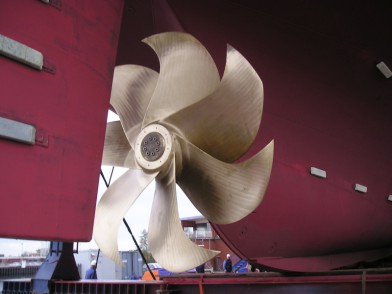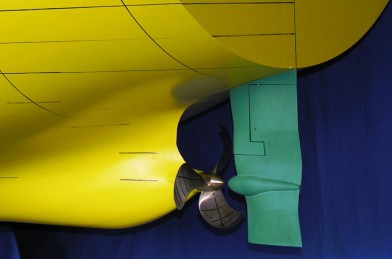Major parts of design programs have been developed in the SVA. This includes pre-processing for propeller definition and geometry modification and recalculation processes for propellers, ducted propellers, twin and contra-rotating propellers. Furthermore, mathematically based optimisation methods and post-processing for assessment of cavitation, pressure fluctuation predictions and strength calculations using FEM analysis, and interfaces for 3D modeling are included. All of these programs are contained within the program package of VORTEX. Other propeller manufacturers and classification societies use, among other things, this software for design and certification. The continuous development of design tools is supported through close contact with these propeller manufacturers and classification societies.
The SVA has had, among other things, significant contributions to the development of the twin propeller concept from SCHOTTEL and set milestones in the development of low-noise propellers for research, naval vessels and submarines. For large tug boats, ducted propellers are designed with more than 200 t thrust. In the development of ducted propellers with high static thrust demands in particular, the broad experience with extensive CFD calculations of propulsion systems on the ship can be made use of.
Designs of propellers and propulsion systems can be fully tested in the SVA in model scale, whereupon despite advanced calculation methods, model testing cannot be dispensed with. After propulsion or cavitation testing, the propeller design can be improved to meet the highest standards of practice.
To determine the behaviour of ship and propulsion system and the tuning of the engine, trial runs are accompanied by the SVA during which special full-scale measurements (power measurement, vibration, pressure fluctuations and acoustics measurements, cavitation observations, manoeuvring measurements) are conducted.
Context Related References / Research Projects
[1] Schulze, R.: Globale Optimierung von Propellern, STG-Sprechtag, Flensburg 14. März 1997
[2] Schulze, R.; Bertolo, G.; Brighenti, A.; Kaul, S.: LUITO Development and Optimisation of the Propulsion System; Study, Design and Tests
PRADS, The Hague, September 20 – 25, 1998, 1998 Elsevier Science B.V.
[3] Schulze, R.: Globale Optimierung von Propellern und Propulsionssystemen, Schiff & Hafen 3/2005
[4] Mertes, P., Heinke, H.-J.: Aspects of the Design Procedure for Propellers Providing Maximum Bollard Pull, ITS 2008, Singapore, May 2008
[5] Steinwand, M.; Grabert, R.; Schulze, R.: Ruderentwurf – Aktuelle Entwicklungen, 102. STG Jahreshauptversammlung, Berlin, 23. Nov. 2007
[6] Schulze, R.; Richter, H.: Redundante Antriebe für Einschraubenschiffe, 102. STG Jahreshauptversammlung, Berlin, 23. Nov. 2007
[7] Schulze, R., Weber, A.: Application of the new FORTJES&rmark; Z-drive from REINTJES on planning vessels; 11th Intern. Conference on Fast Sea Transportation, FAST 2011, Honolulu, Hawaii, USA, Sept. 2011
[8] Schulze, R., Weber, A.: The new FORTJES&rmark; Z-drive from REINTJES with cotra rotating propellers for high speed applications, 11th Intern. Conference on Fast Sea Transportation, FAST 2011, Honolulu, Hawaii, USA, Sept. 2011
[9] Heinke, H.-J., Lübke, L. O.: Maßnahmen zur Energieeinsparung, Schiff & Hafen 10/2014

